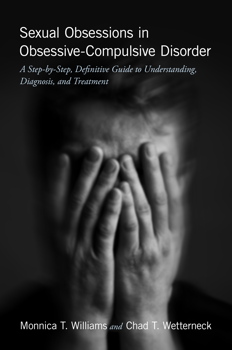Expert Help for OCD
Take Your Life Back from OCD
Offering expert treatment for all types of OCD, including unwanted obsessional thoughts. Our OCD treatment program is typically 10 weeks. We offer twice-weekly sessions, groups, and intensive programs. Intensive program can be in person or online. Low cost options available. Contact us...
Behavioral Wellness Clinic
392 Merrow Rd, Suite E,
Tolland, CT 06084
Office: (860) 830-7838
OCDTYPES
Obsessive-compulsive disorder comes in many forms
Sexual Obsessions in OCD:
A Step-by-Step, Definitive Guide to Understanding, Diagnosis, and Treatment
Monnica T. Williams, Ph.D., ABPP & Chad T. Wetterneck, Ph.D.

DOI: 10.1093/med-psych/9780190624798.001.0001
Specialty: Clinical Psychology, Psychosocial Interventions and Psychotherapy
ISBN: 9780190624798
Disorder: Sexual Disorders, Obsessive-Compulsive Disorder
Although there have been several manuals written about how to treat obsessive-compulsive disorder (OCD) using cognitive-behavioral therapy (CBT), there has been little focus on applying these solid principles to help those suffering from distressing sexual obsessions. Treating sexual obsessions in OCD is different from treating of other forms of OCD due to greater feelings of shame from symptoms, widespread misdiagnosis from doctors and therapists, and the hidden nature of ritualizing behaviors.
The world experts on sexual symptoms in OCD, Dr. Monnica T. Williams, Ph.D., ABPP & Dr. Chad T. Wetterneck, Ph.D., have written this book to help more people with this challenging form of OCD get better.
Sexual OCD Can Be Treated
This book gives mental health professionals the tools needed to successfully help clients suffering from unwanted, intrusive thoughts of a sexual nature. It provides instructions on how to diagnose OCD in clients reporting sexual obsessions, guidance on measures to employ during assessment, and a discussion of differential diagnoses. It includes a step-by-step manual describing how to provide treatment, using a combination of exposure and ritual (response) prevention (Ex/RP), cognitive therapy, and newer CBT techniques. Also included are case examples of pedophile-themed OCD (sometimes called P-OCD) and sexual orientation worries in OCD (called SO-OCD or H-OCD) and their treatment approaches, along with a catalogue of specific ideas for in vivo exposures and detailed templates for imaginal exposures. Included are strategies therapists can use to tackle relationship issues that commonly emerge as a result of sexually-themed OCD. This book also has several appendices of handouts and helpful measures for therapists to use clients.
Sexual Obsessions in OCD is available from Amazon.com (USA) and Amazon.ca (Canada), and it is now also available as an audiobook.
Expert Praise
"This is an exceptionally impressive and comprehensive book! Specific examples of hierarchies, step-by-step treatment descriptions for sexual obsessions are well written. Adding 'third wave' treatments- ACT and Association Splitting provides richness to standard ERP/CBT approaches. Sexual obsessions are confusing for most clinicians. This book is among those considered a seminal resource for OCD practitioners and will receive high acclaim."
— Barbara Van Noppen, PhD, LCSW, Vice Chair for Faculty Development, Associate Professor at USC, President, OCD Southern California, an affiliate of the International OCD Foundation
"Finally, a book dedicated to understanding sexual obsessions in OCD! Williams and Wetterneck, two leaders in the field of OCD assessment and treatment, have compiled an expert cast of authors who intimately examine how to conceptualize, assess, and treat sexual obsessive-compulsive symptoms. This valuable text belongs on the shelf of any clinician specializing in OCD and related disorders."
— Eric Storch, PhD, Professor and McIngvale Presidential Endowed Chair, Vice Chair & Head, Psychology, Menninger Department of Psychiatry and Behavioral Sciences, Baylor College of Medicine
"Williams (Univ. of Ottawa) and Wetterneck, both highly respected clinical psychologists, have produced what is arguably the magisterial volume on approaching sexual obsessions in obsessive compulsive disorder (OCD). The authors present eight expansive and rich chapters, some cowritten with other clinicians and researchers, covering assessment and diagnosis, treatment techniques, and specific subjects such as relationship issues and pedophile obsessions. Extensive appendixes offer material that can be reproduced for clients, as clinical measures, and as templates for session notes. This much-needed volume draws on evidence-based practices such as cognitive behavioral therapy, exposure and response prevention, and mindfulness-informed practices such as acceptance and commitment therapy. One of the strengths of the volume is precisely its open approach to a multitude of practices without sacrificing the depth required to guide practitioners who must work with a challenging population of clients. There is currently no better book on the sexual obsessions specific to OCD, and this definitive volume serves as an indispensable resource for students and practitioners of psychology, psychiatry, and social work, as well as those employed in allied mental health fields.
— M. Uebel, University of Texas
Sexual Obsessions in OCD
Book Contents
INTRODUCTION
- Sexual Obsessions in OCD: A Misunderstood Diagnosis
- Sexual Obsessions in OCD are Common
- Why this Manual is Needed
- Summary & Special Features
CHAPTER 1: Understanding Sexual Obsessions
- About OCD
- The Many Faces of OCD
- About Sexual Obsessions in OCD
- Sexual Obsessions Across Ethnicity, Race, and Culture
- Common Types of Sexual Obsessions
- Pedophile Obsessions
- Sexual Orientation Obsessions
- Religious Sexual Obsessions (Scrupulosity)
- Sexual Assault Obsessions
- Impregnating Obsessions
- Are People with Sexual Obsessions Dangerous?
- What is the Prognosis for People with Sexual Obsessions?
- Treatment Options
- Psychotherapies for OCD
- Alternative Treatments for OCD
- Medications for OCD
- Options for Treatment Refractory OCD
CHAPTER 2: Assessing Clients with Sexual Obsessions
- Consultation
- Disarming Shame
- Explaining the OCD Cycle
- “Where did my symptoms come from?”
- Why Talk Therapy Won’t Work
- Doubting the Diagnosis
- OCD Treatment: What to Expect
- Assessment
- Intake Questionnaire
- Comorbidities in OCD
- Assessment Instruments
- Recommended Measures (Table)
- Differential Diagnosis
- OCD versus Pedophilia
- Issues Diagnosing Pedophilic OCD
- OCD versus Sexual Identity Confusion
- Issues Diagnosing Sexual Orientation Themed OCD
- Issues Diagnosing S-OCD: Transgender Example
- Issues Diagnosing in S-OCD: Woman Claims to be a Pedophile
- Issues Diagnosing in S-OCD: Fears about Bestiality
- What Therapists Need to Know about Medications for OCD
- Drugs, therapy, or both?
- “Why did my medicine stop working?”
- Medications for Sexual Obsessions
- Sexual Side Effects in Sexual OCD
- Communicating with Other Mental Health Care Providers
- Physicians & Other Prescribers
- Therapists
- Social Workers / CPS
- Clergy & Traditional Healers
CHAPTER 3: Step-by-Step Treatment Manual
- Psychoeducation
- Unwanted Sexual Thoughts: Everyone has Them
- Face your Fears: How CBT Will Help
- Commitment to Treatment: Building Mental Fitness
- Exposure and Ritual Prevention (Ex/RP)
- Subjective Units of Distress (SUDS)
- Building the Hierarchy
- Exposure Basics
- Ritual Prevention
- Spoiling Rituals
- Ritual Monitoring
- In Vivo Exposures
- Out-of-Office Exposures
- Imaginal Exposures
- Homework
- Inhibitory Learning: Is Habituation Necessary?
- Cognitive Techniques
- Can you reason with OCD?
- Thought Records
- Behavioral Experiments
- Dropping Concealment Experiment
- Acceptance and Mindfulness Approaches
- Relapse Prevention
- Session-by-Session Outline for Ex/RP
CHAPTER 4: Association Splitting
- A Semantic Network Conceptualization of Obsessions
- What is association splitting?
- Association splitting: A case description
- Similarities and differences between association splitting and other approaches
- Research Evidence for Association Splitting
- Why use association splitting?
- Step-by-Step Instructions for Association Splitting
CHAPTER 5: Treating Sexual Orientation Obsessions
- Case Example
- Case Introduction
- Presenting Complaints
- History
- Assessment
- Case Conceptualization
- Course of Treatment and Assessment of Progress
- Complicating Factors
- Access and Barriers to Care
- Follow-Up
- Treatment Implications of the Case
- Recommendations to Clinicians and Students
- In Vivo Exposure Suggestions (10 examples)
- Sample Imaginal Exposures (11 examples)
CHAPTER 6: Treating Pedophile Obsessions
- Case Example
- Case Introduction & Presenting Complaints
- History
- Assessment
- Case Conceptualization
- Course of Treatment and Assessment of Progress
- Complicating Factors
- Follow-Up (how and how long)
- Treatment Implications of the Case
- Recommendations to Clinicians and Students
- In Vivo Exposure Suggestions (11 examples)
- Sample Imaginal Exposures (11 examples)
CHAPTER 7: Relationship Issues
- Impact of Sexual Obsessions on Relationships
- Sexual OCD can Impair Relationships
- Understanding the Fears Behind the Obsessions
- Family Accommodations
- Family Counseling and Interventions for Sexual Obsessions
- How OCD Affects Partners
- Helping Partners Understand
- Differences in Views about Mental Illness
- Cultural Issues
- Sexual Problems in OCD: Sex and Anxiety Don’t Mix
- Impregnating Obsessions
- Sexual Orientation Obsessions
- Obsessions Surrounding Sexual Deviance
- Contamination Fears
- Anxiety and Depression Reduces Sex Drive
- Medication Side Effects
- Talking to Partners
- Relationship OCD (R-OCD)
CHAPTER 8: Troubleshooting Common Problems, Issues, & Resources
- Therapist Discomfort Discussing Sexual Topics
- Troubleshooting for Busy Professionals
- Insurance Coverage for 90-min Session
- Client has Comorbid Depression
- Client Won’t Adhere to CBT Treatment Elements (session, homework, etc.)
- Client does some exposures but refuses to do exposures that don't feel “safe enough”
- Client Worried about Getting Sexually Aroused During Exposure
- Client Says “I Cannot Stop Mental Compulsions”
- Is sending clients to a gay club too extreme?
- Is treating clients with sexual orientation OCD any different than reparative therapy?
- Imaginal Exposure Not Causing Anxiety
- “Exposures are not working.”
- How explicit should exposures be?
- Issues with Adolescents and their Parents/Caregivers
- Issues with Clients with Developmental and Cognitive Delays
- Shame, Guilt and Embarrassment in Adolescents
- When OCD Clients Mention Suicide
- OCD and Substance Use
- Support Groups for S-OCD
- Issues with Exposures in Public Locations
- Reducing Accommodations
- Troubleshooting for unsupportive home life and family
- Helping family members motivate individuals with OCD into treatment
- What are some good books for clients and family members about S-OCD?
- Where can therapists learn more about treating this kind of OCD?
APPENDICES
A. Materials for Clients (Preview here at OUP)
- 1. Handout: Symptom Dimensions & Unacceptable Thoughts (Diagram)
- 2. Handout: The OCD Cycle (Diagram)
- 3. Compulsion Monitoring Log with Instructions
- 4. Handout: Understanding OCD & S-OCD (with quiz)
- 5. Handout: Understanding Unacceptable Thoughts in OCD (with quiz)
- 6. Handout: Understanding CBT for OCD (with quiz)
- 7. Handout: Unwanted Sexual Thoughts
- 8. Creating a SUDS Scale
- 9. Homework Forms for Exposures
- 10. Guidelines for Normal Behavior and Relapse Prevention
- 11. Relapse Prevention
B. Measures (Preview here at OUP)
- 1. Family Accommodation Scales
- 2. SO-OCD Scale (SORT)
- 3. Adult OCD Impact Scale (AOIS)
- 4. Dimensional Obsessive Compulsive Scale (DOCS) plus new sub-scale for S-OCD
- 5. Sell Assessment of Sexual Orientation
- 6. Behavioral Activation for Depression Scale – Short Form (BADS)
C. Session Notes (Preview here at OUP)
- Session 0: Consultation Form
- Session 1: Intake Form (Assessment & Diagnosis)
- Session 2: Case Formulation Form Part 1 (for YBOCS-II results)
- Session 3: Case Formulation Form Part 2
- Session 4: Treatment Planning with Hierarchy Form
- Session 5+: Session Notes with Exposure
- Final Session Form
Development of a client workbook is underway at the Center for Mental Health Disparities.

